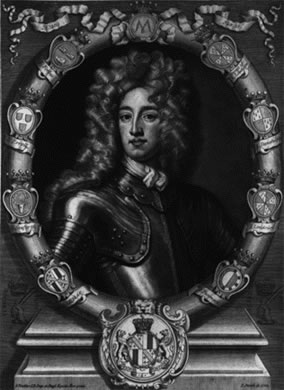Plans for a Jacobite Rising
 Since 1690, the court at Saint-Germain had been plotting a landing on the Northumbrian coast followed by the seizure of Newcastle. By 1714, with Jacobite hopes of a constitutional restoration ruined and George I firmly on the throne, the idea began to be discussed seriously once again.
Since 1690, the court at Saint-Germain had been plotting a landing on the Northumbrian coast followed by the seizure of Newcastle. By 1714, with Jacobite hopes of a constitutional restoration ruined and George I firmly on the throne, the idea began to be discussed seriously once again.
Three leading Tories who had all held ministry under Queen Anne had, for different reasons, come over to the Jacobite side, and these three men now took on the planning of an armed Jacobite rising in England. They were John, Earl of Mar, Henry St. John, Viscount Bolingbroke, Secretary of State to Queen Anne, and James, Duke of Ormonde, an Irishman who had been Captain-General under Anne. These three men were able to travel around the kingdom and to France, liaising with leading Jacobites and estimating the strength of Government support. They began to formulate serious plans for a full-scale Jacobite rising in England.
On 1 September 1715 the court in Saint-Germain finally agreed on a plan of campaign. Two Jacobite armies would be raised in the North, one in Northumberland and one in Scotland. These armies would act as a feint, drawing the Government army away from London and then refusing to engage it in battle. Once the Hanoverian forces were committed, the King would land in the South-west, raise the local population, meet with the rebels from Wales, march to Oxford, a Jacobite stronghold, and then on into London. Captain Robert Talbot, an Irish Catholic, took ship for Newcastle carrying orders that the Northumbrian Jacobites were 'to be ready to rise upon warning given' (Patten).
Preparations for the Northumbrian Rising
The orders from France were kept highly secret and were given only to the senior local Jacobites. These men now began to raise support in their home areas. Derwentwater at Dilston prepared the Tyne Valley, Forster at Bamburgh planned the capture of Holy Island, Widdrington prepared to ride into the North-west to ensure Jacobite support there and Blackett hoped to win over the authorities in Newcastle.
It was a vital part of the plans that the intentions of the plotters be kept secret. A rising could only succeed if the local Government forces were unaware of it and were not reinforced from the South. In mid-September, news came that Mar had arrived at Braemar on the 9th and gathered the clans, and the final touches were put to the plans for a rising. The conspirators eagerly awaited the order for the rising to begin. Things, however, were not going to go according to plan.......
Derwentwater had warned Mar and the other leaders of the projected rising to guard their plans with extreme secrecy. This they had markedly failed to do. The Hanoverian Government seems to have known exactly what the Jacobites planned. Only in Northumberland and in the Highlands did the Government fail to penetrate the Jacobite faction. The Government had a full list of Jacobite plans in the South of England, and the names of the leaders. In early October the Government sprang the trap with great efficiency. The main Jacobite leaders in the South were arrested or fled into exile. Arms were seized, and Oxford subdued at bayonet point. This meant that by 22 September any hope of a rising in the South was gone.